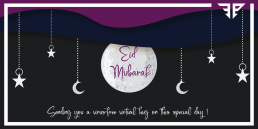What is Eid-Al-Fitr?
Eid al-Fitr is a religious holiday celebrated by Muslims worldwide to pay respects to Allah for providing strength and endurance during the month-long fasting rituals & signifies that month-long dawn-to-sunset fasting of Ramadan has come to an end.
Muslims adore new traditional clothes for the occasion of Eid. Eid-al-Fitr starts with a dedicated prayer salah knows as the Eid Salah which is offered in congregations followed by a sermon.
After the sermon is over, people greet each other “Eid Mubarak” by shaking hands or hugging each other signifying the peace, harmony, unity & love amongst the community.
A lot of activities go along varied by local traditions & customs. A famous tradition of serving Sheer khurma is well known.
Sheer khurma or sheer khorma is a festival vermicelli pudding prepared by Muslims on Eid ul-Fitr and Eid al-Adha in Afghanistan, Pakistan, India and parts of Central Asia. It is a traditional Muslim festive breakfast, and a dessert for celebrations. (Wikipedia)
There’s also a well-known practice of giving gifts to the children, middle-aged and elderly alike known as Eidi which makes it an interesting and fun-filled occasion for them.
Origin of Ramadan
In 610, the angel Gabriel appeared to Prophet Muhammad and revealed to him the Quran, the Islamic holy book. That revelation, Laylat Al Qadr—or the “Night of Power”—is believed to have occurred during Ramadan.
Ramadan is celebrated as the ninth month of the Muslim calendar. Celebrating Ramadan is a way to honour Muhammad & the commandments of Allah and develop more self-control.
This is done through the practice of sawm or fasting from drinking, or eating dawn through dusk. During this fasting period, one needs to refrain from impure speech, and sexual activities. People who are not physically able to participate must serve the poor, and fast when they can. Exemptions to fasting include travel, menstruation, severe illness, pregnancy, and breastfeeding.
The start of Ramadan fluctuates each year because the lunar Islamic calendar follows the phases of the moon. The beginning and end of Ramadan are determined by a Moon sighting committee in Saudi Arabia & other countries. It begins the day after the committee spots the new crescent moon, which can be tricky since it’s quite faint and can be seen for only about 20 minutes. If the moon isn’t visible to the naked eye because of haze or clouds, lunar calculations are used to predict whether it’s in the sky.
After a sunset prayer, this introspection can be broken with a meal with friends and family called the “iftar,” which reinforces family and the brotherhood.
Significance
The embodiment of reflection, revelation, revolution, and restoration, the month offered any true seeker a self-reflective course that has the power to bring a revolution of the heart and help restore justice, peace and harmony in the world.
There is salvation in this month; a chance to be cleansed of all sins and reborn again. Ramadan is a gift from Allah (SWT); an opportunity for Muslims to capitalize on and earn his blessings and a way to seek salvation and forgiveness.
Ramadan is the most sacred month of the year for Muslims — the Prophet Mohammed reportedly said, “When the month of Ramadan starts, the gates of heaven are opened and the gates of hell are closed and the devils are chained.”
Origin of Islam
Adherents of Islam are known as Muslims (or) Moslems. Islam originated in Mecca, and now is the world’s second largest religion, with over a billion followers, and six billion in the US. Muslims believe that Muhammad received the first revelations from Allah during Ramadan and as such hold special importance for it.
There are five pillars of Islam besides fasting. Prayer is called the Salat, where believers pray five times a day.
There is the Zakat, giving to others and charity. The Shahadah is acknowledging that there is no higher being than God, and Mohammed. Hajj is that all Muslims go to Mecca during their lifetime.


